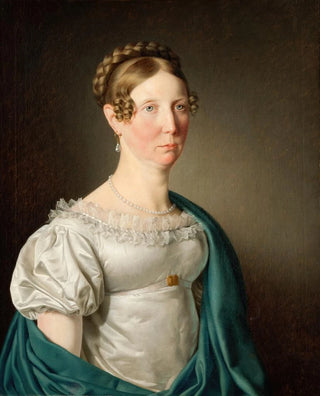Art print | Portrait of a lady - Christoffer Wilhelm Eckersberg


View from behind

Frame (optional)
Christoffer Wilhelm Eckersberg's "Portrait of a Lady" is an iconic artwork that embodies the elegance and finesse of 19th-century portraiture. This painting, created by a Danish master, captures not only the external beauty of its subject but also a psychological depth that invites viewers to reflect on this woman's inner life. Contemplating this piece transports one to a universe where time seems suspended, where every detail is meticulously crafted to evoke an atmosphere of grace and delicacy. The work, while rooted in its era, transcends simple conventions of portraiture to offer a visually intense experience.
Style and uniqueness of the artwork
The uniqueness of this piece lies in Eckersberg's technical mastery, which manages to blend realism and idealization. The lady's features are rendered with remarkable precision, each shadow and light contributing to a striking volume. The choice of colors, delicate and harmonious, evokes a soft palette that flatters the eye while adding an emotional dimension to the overall composition. Eckersberg also uses a neutral background that highlights the subject, allowing the lady's personality to stand out without distraction. This portrait is not limited to a mere representation; it is an open window into the woman's soul, an invitation to explore her thoughts and feelings. This subtle blend of technique and emotion makes this work a masterpiece of European portraiture.
The artist and his influence
Christoffer Wilhelm Eckersberg, often regarded as the father of Danish realism, played a fundamental role in the evolution of art in Denmark and beyond. Trained at the Royal Danish Academy of Fine Arts in Copenhagen, he skillfully integrated influences from neoclassicism and romanticism to develop a style that is uniquely his own. His innovative approach inspired many contemporary artists and paved the way for a new way of conceptualizing the portrait. Eckersberg does not merely reproduce reality; he seeks to capture the very essence of his subjects, immortalizing them in a moment of truth. His contribution to art extends beyond his individual works.

Matte finish

View from behind

Frame (optional)
Christoffer Wilhelm Eckersberg's "Portrait of a Lady" is an iconic artwork that embodies the elegance and finesse of 19th-century portraiture. This painting, created by a Danish master, captures not only the external beauty of its subject but also a psychological depth that invites viewers to reflect on this woman's inner life. Contemplating this piece transports one to a universe where time seems suspended, where every detail is meticulously crafted to evoke an atmosphere of grace and delicacy. The work, while rooted in its era, transcends simple conventions of portraiture to offer a visually intense experience.
Style and uniqueness of the artwork
The uniqueness of this piece lies in Eckersberg's technical mastery, which manages to blend realism and idealization. The lady's features are rendered with remarkable precision, each shadow and light contributing to a striking volume. The choice of colors, delicate and harmonious, evokes a soft palette that flatters the eye while adding an emotional dimension to the overall composition. Eckersberg also uses a neutral background that highlights the subject, allowing the lady's personality to stand out without distraction. This portrait is not limited to a mere representation; it is an open window into the woman's soul, an invitation to explore her thoughts and feelings. This subtle blend of technique and emotion makes this work a masterpiece of European portraiture.
The artist and his influence
Christoffer Wilhelm Eckersberg, often regarded as the father of Danish realism, played a fundamental role in the evolution of art in Denmark and beyond. Trained at the Royal Danish Academy of Fine Arts in Copenhagen, he skillfully integrated influences from neoclassicism and romanticism to develop a style that is uniquely his own. His innovative approach inspired many contemporary artists and paved the way for a new way of conceptualizing the portrait. Eckersberg does not merely reproduce reality; he seeks to capture the very essence of his subjects, immortalizing them in a moment of truth. His contribution to art extends beyond his individual works.






